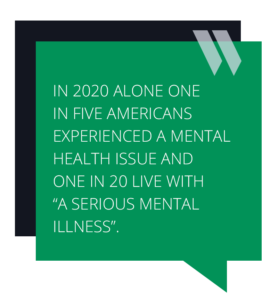Behavioral and mental health issues have always been incredibly complex, to say the least, but two factors are making it increasingly apparent that our current healthcare model is spectacularly ill-equipped to effectively provide help.
First, mental health disorders are much more widespread than most realize: in 2020 alone one in five Americans experienced a mental health issue and one in 20 live with “a serious mental illness.” Some mental illnesses – like depression – are also considered chronic: with 21 million Americans suffering from at least one depressive episode. Other forms of chronic illness (e.g., cardiovascular, diabetes) also produces depression as a comorbidity.
Second, insurance providers make getting consistent help for mental health problems extraordinarily challenging. As others have noted, “in addition to inadequate mental health provider networks, [they] sometimes use restrictive standards to limit coverage for mental health care….these standards make it extremely difficult to get treatment covered.” That’s the exact opposite of what most patients with ongoing mental or behavioral health issues need – and consequently, there’s very little chance of meaningful, lasting improvement for them.
But until the system changes, there are obvious ways to make care better. That’s something that we’re proud to support through developing technology that can unite care teams in an approach to behavioral and mental health that’s long-term, patient-centered, wellness-focused, highly communicative, and hyper-practical.
Expand the circle
It’s about facilitating team expansion. People suffering from a mental or behavioral health issue need clinicians at the right time – but they don’t need them every time. They need regular, compassionate communication that other team members – like physicians’ assistants, therapists, counselors, and even office staff – can provide. It’s about keeping the lines of communication open and flowing so that issues can be more quickly flagged, crises can be elevated, and assessments can be made to help get the patient back on track.

Create a collaborative community
It’s also about encouraging community – when you have a care team model in place to augment family and friends, technology can actually support trust and relationship building. Though the human touch is the primary way those patient relationships are built and sustained, automating some of the lightweight check-ins – like appointment reminders, questionnaires, rating your mood that day, and sharing helpful resources – can reinforce those feelings. Plus, when care team members don’t have to execute those tasks, they can spend that time on higher-value tasks that help patients.
Visibility
Accountability is core to treating mental and behavioral health issues; it’s fundamental to the recovery process. But working with patients to get there is very challenging in the best of circumstances; the journey in these cases is never, ever linear. Technology can help because a platform approach puts every care team member on the same page through exceptional visibility. And it also ensures that patients themselves become more invested and active in their care – because with visibility comes action.
Able to see the same playbook and armed with the same insights, care team members can move faster. Tools – like alerts when an appointment is missed, a test result comes in, or an interaction seems off – can quickly surface that a patient may need help. That’s especially important in a behavioral and mental health context, where tracking adherence to a treatment plan is especially crucial. Ultimately, this visibility provides the impetus for action and can even prompt with suggested next steps. It’s an invisible layer of support that ensures a patient does not fall through the cracks unintentionally.
I’m proud of the technology we’re building at Welkin to help mental health caregivers more effectively support patients. Their jobs are extraordinarily difficult and important in equal measure; if technology can lighten the load, enhance their ability to provide care, and improve patient outcomes, it should.
And that’s what we’re doing.
About the Author:
Michelle Pampin is the CEO of Welkin Health, a Care Management platform focused on improving health outcomes for people living with chronic diseases. Michelle is an accomplished leader, with a track record of advancing high-growth Silicon Valley software companies. Michelle speaks three languages: Spanish, French and Portuguese. When she’s not busy leading Welkin, she is busy staying active with her Samoyed, Avi.



